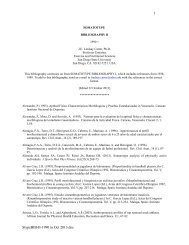THE HEATH-CARTER ANTHROPOMETRIC ... - Somatotype.org
THE HEATH-CARTER ANTHROPOMETRIC ... - Somatotype.org
THE HEATH-CARTER ANTHROPOMETRIC ... - Somatotype.org
You also want an ePaper? Increase the reach of your titles
YUMPU automatically turns print PDFs into web optimized ePapers that Google loves.
<strong>Somatotype</strong> Instruction Manual 11<br />
The SAM is calculated by dividing the sum of the SADs from their mean somatopoint by the<br />
number of subjects.<br />
*********<br />
Part 2: <strong>Somatotype</strong> Analysis<br />
[This article is similar to sections in Ross, WD, Carr, RV and Carter, JEL, (1999). Anthropometry<br />
Illustrated (CD-Rom). Surrey, Canada: Turnpike Electronic Publications, Inc., 1999, used with<br />
permission.]<br />
The purpose of Part 2 is to draw attention to some basic concepts of somatotype analysis, comment on<br />
recent applications, and provide a guide for investigators. The intent is to give general rather than<br />
detailed procedures. For the latter the reader is referred to Carter (1996), Carter et al. (1983), Carter<br />
and Heath (1990), Duquet and Carter (1996) and Sodhi (1991).<br />
The most widely applied method for obtaining the somatotype is the anthropometric method of Heath<br />
and Carter (1967), which has been modified slightly since it was first, published. Important changes<br />
include the conversion to a rating form in metric units, the use of a height adjustment for endomorphy<br />
which is now standard procedure, and the use of equations, instead of the rating form, to calculate the<br />
component ratings (Carter and Heath, 1990). Recently, Rempel (1994) has developed modifications of<br />
the rating form and equations so that the scales are truly size dissociated. His modifications are sound<br />
and when tested further they will probably be accepted as the preferred methods for calculating<br />
somatotype ratings.<br />
Analysis of the three-number somatotype rating presents some unusual problems to the uninitiated. How<br />
should such a rating be analyzed? Early solutions typically involved either analyzing the three component<br />
ratings separately, or grouping somatotypes and comparing the frequencies. During the 1970s and<br />
1980s more sophisticated analyses, appropriate for analysis of the somatotype as a whole, were<br />
developed. These were summarized in a series of publications, Hebbelinck et al. (1973), Duquet and<br />
Hebbelinck (1977), Carter (1980), Carter et al. (1983) and Carter and Heath (1990). An important<br />
element of these developments was the ability to analyze whole somatotypes in two or three dimensions<br />
using appropriate equations, which led to application of conventional statistical analysis. These equations<br />
quantified the distances between somatotypes. The two and three-dimensional distances between pairs<br />
of somatotypes are called the somatotype dispersion distance (SDD) and somatotype attitudinal<br />
distance (SAD) respectively. The average of the distribution of somatotypes about their mean is called<br />
the somatotype dispersion mean (SDM) in two dimensions, and somatotype attitudinal mean (SAM) in<br />
three dimensions. Because the SAD and SAM, which are based in three dimensions, contain more<br />
accurate information about the true distances between somatotypes than the SDD and SDM, which are<br />
based in two dimensions, the three dimensional approach is recommended for most analyses. These<br />
equations are given in the references cited above, as well as later in Part 3.<br />
Procedures




